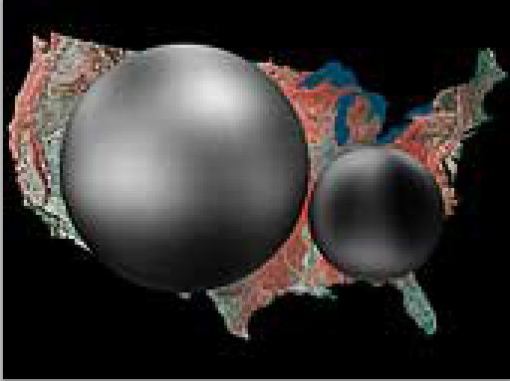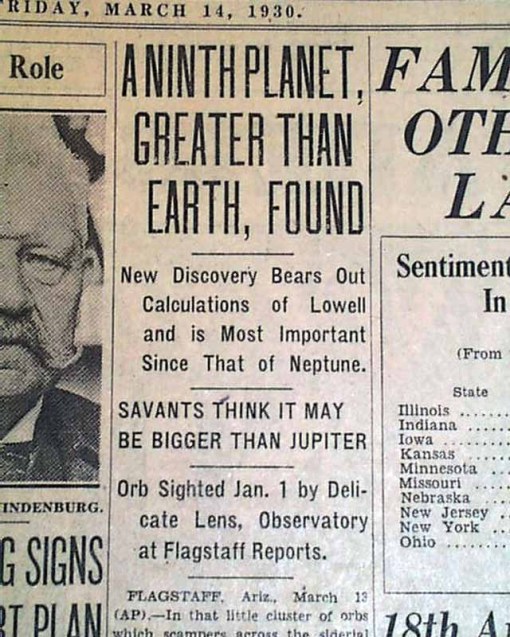Hence the pizza! Nice of the NY Times Op-Ed page to allow me a little room to celebrate what would have been Clyde Tombaugh’s 105th birthday.
Is it a planet?
February 5, 2011
My Very Eager Mother Just Served Us New Pizza…
Posted by plutovian under Clyde Tombaugh, Is it a planet?, Lowell Observatory1 Comment
January 30, 2011
Tombaugh’s credit.
Posted by plutovian under blogroll, Clyde Tombaugh, Constance Lowell, Is it a planet?, Percival Lowell, Vesto Slipher1 Comment
A blogger at the Philadelphia Area Center for History of Science has been writing about the Planet X story lately; in his most recent post, Darin points out that in the initial announcement in 1930, V.M. Slipher went out of his way to credit Percival Lowell for leading the way to the planet’s ultimate discovery — while underplaying Clyde Tombaugh’s central role in the painstaking photographic search.
The extension of credit to Lowell, and the relative under-recognition of Tombaugh, could suggest that Slipher simply knew where his bread was buttered. You give credit to the man with his name on the letterhead, after all, not the undereducated farmboy from Kansas. And part of the mission of Lowell Observatory was to rehabilitate the reputation of its founder, who was thought to be a bit of a kook.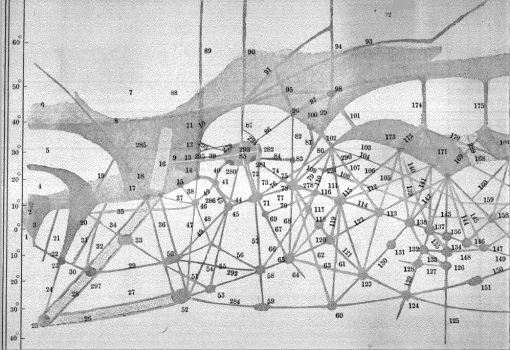
(For example, Lowell had believed passionately in the existence of a Martian civilization — sustained by an elaborate series of canals.)
It’s worth noting that Slipher’s relationship to Lowell — and the Lowell family — was (understandably) a complicated one. By 1930, Slipher’s old friend Lowell had been dead for fourteen years. Constance, Percival’s widow, had been a thorn in Slipher’s side since the astronomer’s death, spending more than a decade fighting Lowell’s multimillion-dollar bequest to his own Observatory and cutting the astronomers’ salaries in the bargain. On the other hand, once the Planet X project got underway again in 1928, the Lowell family (apart from Constance) invested substantially in the equipment needed, including the remarkable triplet lens the 13-inch astrograph required. It can be imagined that the family expected results from their investment, and that Slipher’s emphasis of Lowell’s role in the discovery of Planet X was indeed at once an acknowledgment of his old friend’s ancient, originating ambition and a recognition of the family’s more recent, crucial involvement.
But consider another line as well. Slipher — and others involved in the Planet X search — knew they had an unusual case in Pluto. Even before announcing their discovery to the world, they had tipped to the notion that Lowell’s calculations had not in fact been borne out by the discovery of Planet X, because it was too small to have been detected mathematically. Still, one can imagine Slipher and the others being reluctant to get in the way of a good news story. We don’t know who wrote “confirmed” here in the headline, but I bet Slipher didn’t protest too much.
Note that this question should be distinguished from the matter of whether Planet X should have been called a “planet” to begin with. What other word would have fit? Though its exact dimensions weren’t clear, it was still thought to be a fairly large object. Certainly it was no asteroid.
December 13, 2010
Back in October I had the chance to give a talk in conjunction with Dr. Bruce Greenway, a fellow Michigander and an actual professional astronomer. He made the most convincing case I’ve seen for Pluto’s reclassification — demonstrating beyond the shadow of a doubt that Pluto has far more in common with objects like Eris, Ceres, and Pallas than bodies like Mercury, Mars, Earth, or other canonical planets. The difference in mass is crucial — and the degree to which this massiveness has allowed the principal bodies in question to clear the neighborhood around their orbits. If you’re wondering whether Pluto’s more like Eris or Mercury, this graph ought to make the case plain:
 I’m cribbing this slide from Bruce’s PowerPoint. It points out exactly how drastically the difference in mass affects the amount of other “crap” in the neighborhood. And seems to suggest that — all legacy considerations aside — Pluto ought to be categorized with its fellow dwarves.
I’m cribbing this slide from Bruce’s PowerPoint. It points out exactly how drastically the difference in mass affects the amount of other “crap” in the neighborhood. And seems to suggest that — all legacy considerations aside — Pluto ought to be categorized with its fellow dwarves.
We ought also to be struck by how extremely unlikely it was that Clyde would have seen such a tiny little thing.
July 9, 2010
The smoldering gun.
Posted by plutovian under Clyde Tombaugh, Is it a planet?, Percival Lowell, Vesto Slipher[3] Comments
In the archives of Lowell Observatory, under the excellent guidance of archivist Antoinette Beiser, I came across this typewritten memo – in its original, a few pages long. While it’s not clear who composed this note, someone has penciled “VM?” in the upper margin — Vesto M. Slipher, director of the Observatory.
 In this memo, Slipher (probably) is acknowledging that there was some delay in the announcement of the discovery of Planet X (later Pluto). Clyde Tombaugh found the retrograding trans-Neptunian object on February 18, 1930. Lowell Observatory didn’t announce their findings until March 13. This happened to be Percival Lowell’s birthday — as well as, through one of this story’s many cosmically-arranged coincidences, the date on which Uranus was first discovered.
In this memo, Slipher (probably) is acknowledging that there was some delay in the announcement of the discovery of Planet X (later Pluto). Clyde Tombaugh found the retrograding trans-Neptunian object on February 18, 1930. Lowell Observatory didn’t announce their findings until March 13. This happened to be Percival Lowell’s birthday — as well as, through one of this story’s many cosmically-arranged coincidences, the date on which Uranus was first discovered.
Aside from the pleasing timing, why the delay?
As I’ve written here before, the astronomers at Lowell weren’t sure what they had. The object was too small to be the gas giant they’d been expecting. But their mathematics seemed to indicate that a gas giant was indeed what was out there to discover; only a very large planet could perturb the orbits of Uranus and Neptune in the way that was posited. So they were understandably puzzled to have found a very small object in just the place that Lowell’s mathematics suggested a gas giant would be.
But what’s of interest to me in this memo is the phrase “In view of the unusual character of the discovery into which the institition [sic] and its founder had given so much in the way of effort and time we had to be content to allow the momentary gusts of emotion to blow over…”
One way of reading this goes: we’d been looking for the thing for so long, and under such pressure to find something, that we wanted to make sure we had something genuine before we said anything.
That’s a legitimate reason to hesitate, of course.
But I think, too, that it’s fair to read those three weeks as a pregnant pause, during which the astronomers decided whether to call this object Planet X or not — that is, whether the accumulated pressures of history and institutional expectation outweighed the obvious problems with the object. It wasn’t what they were expecting.
So – should they gamble? Should they go ahead and try to call this object Planet X?
Had it been a gas giant — had they found what they’d been expecting — I bet they would have announced it the next morning. Instead, over the next three weeks, they took countless photographs of the object, hoping to solve their conundrum. They never did. And in the end, of course, they didn’t call it Planet X when they finally announced it. They just called it a “solar system object apparently trans-Neptunian.” It was the press that called it Planet X, and so a planet was born.
May 18, 2010
Alan Boyle, author of The Case for Pluto, makes an eloquent and moving argument for the importance of thinking of Pluto — and its trans-Neptunian brethren — as full-fledged worlds in their own right. Conceiving of them as worthy of the culturally-weighted term “planet” makes a difference in how we see our own position in the solar system:
 “Never again can Pluto be the ninth planet. Or the littlest planet. Or the most distant planet. But does that make Pluto a non-planet? No way. Even before Pluto was discovered, the solar system was divided into two classes of planets: the rocky worlds like Earth, and the gas giants beyond. Pluto has pointed the way to the solar system’s third great class of planets, no less important than the other two…
“Never again can Pluto be the ninth planet. Or the littlest planet. Or the most distant planet. But does that make Pluto a non-planet? No way. Even before Pluto was discovered, the solar system was divided into two classes of planets: the rocky worlds like Earth, and the gas giants beyond. Pluto has pointed the way to the solar system’s third great class of planets, no less important than the other two…
“Alan Stern, the principal investigator for the New Horizons mission to Pluto, says there could be many thousands of icy worlds out on the solar system’s rim–and hundreds of them could well qualify as dwarf planets. Over the long run, that will almost certainly change the way we look at our own place in the universe. And what’s so bad about that?
“‘The original view, until 10 or 15 years ago, was that we had four Earth-like terrestrial planets, four gas giants, and the misfit Pluto. But the new view is four terrestrial planets, four gas giants, and hundreds of Plutos,'” Stern says. “‘It’s jarring, because Pluto’s no longer the misfit. It’s the Earth-like planets that are the misfits.'”
May 17, 2010
TNO? TMI? WTF?
Posted by plutovian under Clyde Tombaugh, Is it a planet?, planetkillers, the solar system1 Comment
Trans-Neptunian Objects isn’t a term used much any longer. “Dwarf planets” is the preferred term, if you’re being PC. (“Little planets”, if you’re being really PC.)
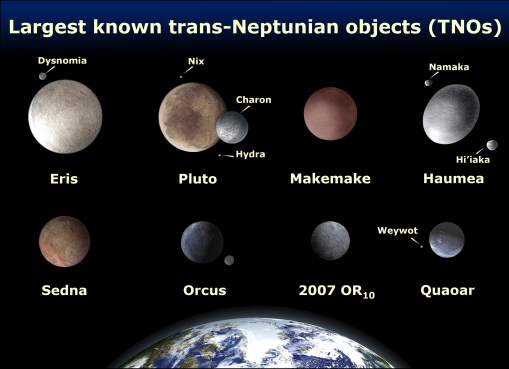 Anyway, these are the biggies. They’re all out beyond Neptune’s orbit. They’re all large enough to be kinda planetlike in some ways — they’re in hydrostatic equilibrium (meaning they get mostly round and stay mostly round). They’re not themselves satellites. But they aren’t large enough to have “cleared their neighboring region of planetesimals,” i.e., to have slurped up all other orbiting bodies unto themselves. Which means, according to the International Astronomical Union’s Resolution 5A of 2006, they aren’t planets.
Anyway, these are the biggies. They’re all out beyond Neptune’s orbit. They’re all large enough to be kinda planetlike in some ways — they’re in hydrostatic equilibrium (meaning they get mostly round and stay mostly round). They’re not themselves satellites. But they aren’t large enough to have “cleared their neighboring region of planetesimals,” i.e., to have slurped up all other orbiting bodies unto themselves. Which means, according to the International Astronomical Union’s Resolution 5A of 2006, they aren’t planets.
And what would Clyde Tombaugh have thought? My impression of Clyde in his later life is of a man at peace with himself. Every picture I’ve seen of him shows him beaming, and surely he was much beloved. Though he defended Pluto’s planetary status when it first was questioned in the 1990s, I believe he also recognized his discovery of Pluto as being something of a happy accident. And today, I can imagine him arguing that we welcome the planetary status of such substantial bodies as Eris, Haumea, Makemake, Orcus, Quaoar, and so on. The universe had made room for him in such an unlikely fashion, after all – I believe he’d have wanted us to return the favor. So on Clyde’s behalf, let the IAU know we want Pluto back!
(Thanks once again to the great Laurel Kornfeld for her ongoing, informed contributions to this discussion – and for filling in some details on the IAU kerfuffle.)
May 13, 2010
How big is Pluto exactly?
Posted by plutovian under Is it a planet?, the solar systemLeave a Comment
April 4, 2010
Planet X is 1200 times bigger than Earth — approximately.
Posted by plutovian under Constance Lowell, Is it a planet?, Percival Lowell, Planet X, Vesto Slipher[5] Comments
News traveled fast. The day after Vesto Slipher made his announcement of Clyde Tombaugh’s discovery, papers around the world ran front-page headlines calling the “trans-Neptunian object” a “planet”. Notice that while the cautious astronomers at Lowell Observatory hadn’t declared the object a planet themselves, the public did it for them.
You have to think Slipher knew this would be the case. After all, finding a planet solved all kinds of problems for the observatory staff — most of all, the problems of expectation. The Lowells, including Percival Lowell’s widow Constance, were keen to end the search with a success story. They’d poured plenty of money, and a lot of heartache, into the project.
How terrible if Lowell had spent all those years just chasing ghosts.
(They don’t write them like this any longer, do they?)
These early reports are typically breathless. Observations in the next few weeks would bear out Planet X’s apparently small size. Rather than being 1200 times the size of Earth, Pluto is smaller than Earth’s moon.
March 9, 2010
It was 2007, and I was standing at the photocopier minding my own business when my friend and colleague Anne Curzan informed me the American Dialect Society had chosen “plutoed” as their word of the year.
“Aw, you gotta be kidding me,” said I.
“Nope,” said she.
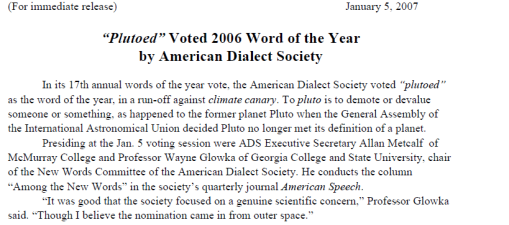 And this of course came only a few months after the demotion of Pluto from planetary status. I was a little angry, and more than a little depressed. I was writing a novel about a planet that didn’t even exist any longer, and now the demotion had entered the vocabulary of the English language.
And this of course came only a few months after the demotion of Pluto from planetary status. I was a little angry, and more than a little depressed. I was writing a novel about a planet that didn’t even exist any longer, and now the demotion had entered the vocabulary of the English language.
But as it turned out, of course, the demotion of Pluto was the best thing to happen to Pluto since it got a cartoon dog named after it. Nobody knew how much they loved Pluto until they’d had it taken away from them — and thus a new generation of Plutovians was born! (Uplifting music here.)
Plus, “plutoed” isn’t a word. I’ve never heard anyone use it, anyway. So there!
December 28, 2009
Notice that in the telegram from Lowell Observatory — the stuff that comes after the colon — nobody calls it a planet – not yet. Why? Because the astronomers at Lowell know they’ve got something weird. The object they’ve discovered on February 18 is definitely retrograding — that is, it’s definitely in orbit around the sun. But in size, color, and composition, the object is not at all what they expected.
 This announcement card was released March 13, 1930 — Percival Lowell’s birthday. By this point, astronomers at Lowell have decided to announce their findings. A planet? A comet? They don’t know.
This announcement card was released March 13, 1930 — Percival Lowell’s birthday. By this point, astronomers at Lowell have decided to announce their findings. A planet? A comet? They don’t know.
They’re further faced with a weird dilemma – that the object is just about where Percival Lowell’s math suggested it would be. But it’s too small to have been discovered through its perturbative effects on Saturn, Uranus, and Neptune. How can this be?


